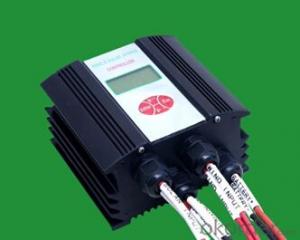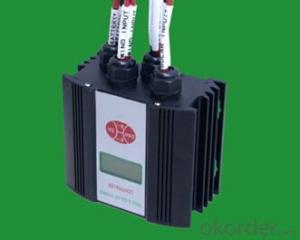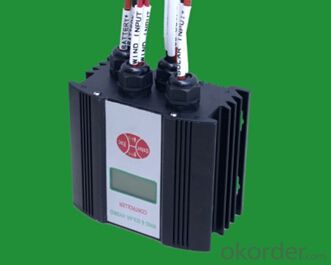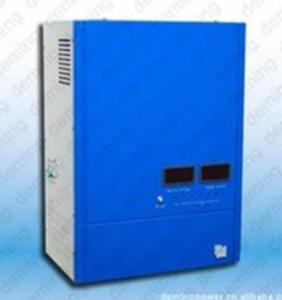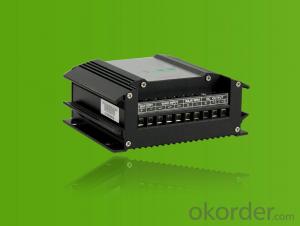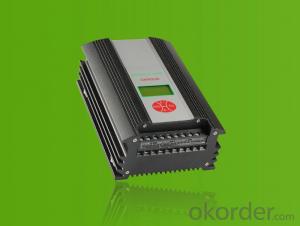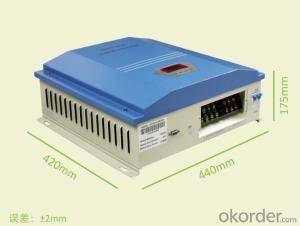Solar Charge Controllers Waterproof Wind Solar Hybrid Street Light Controller
- Loading Port:
- Shanghai
- Payment Terms:
- TT or LC
- Min Order Qty:
- 1 unit
- Supply Capability:
- 5000 unit/month
OKorder Service Pledge
OKorder Financial Service
You Might Also Like
I. PRODUCT INTRODUCTION
The wind/solar hybrid controller is specially designed for high-end small-scale wind/solar hybrid system and especially suitable for wind/solar hybrid street light system and wind/solar hybrid monitoring system.The controller can control wind turbine and solar panel at the same time and transform the wind and solar energy into electricity for DC load use, with excess energy stored into batteries. Varieties of appearance and function design, which is flexible to meet the requirements of different customers.
II. 12V TECHNICAL PARAMETERS
Product Model | WWS02-12-N00D | WWS03-12-N00D | WWS04-12-N00D |
Rated battery voltage | 12V | 12V | 12V |
Rated wind turbine input voltage | 200W | 300W | 400W |
Maximum wind turbine input power | 300W | 450W | 600W |
Wind Turbine Brake Current | 20A | 30A | 40A |
Rated Solar Input Power | 150W | ||
Dumpload Start Voltage | 13.5V | ||
Complete discharge voltage | 14.5V | ||
Battery Under Voltage Shutoff | 10.8V | ||
Battery Under Voltage recovery | 12V | ||
Input over voltage shutoff | 16V | ||
Light Control On Voltage | 1V | ||
Light Control Off Voltage | 1.5V | ||
Rated Output Current of Load 1 and Load 2 | 10A | ||
Load 1 Output Control Mode | Light Control On and Light Control Off | ||
Load 2 Output Control Mode | Light Control On and Time Control 5 Hours Off | ||
Dumpload Control Mode | PWM | ||
Display Mode | LCD | ||
Cooling | Aluminium alloy shell radiating | ||
Protection Level | IP53(Indoor) | ||
Quiescent Current | ≤20 mA | ||
Display Content | Battery Voltage, Wind Turbine Voltage, PV Voltage, Wind Turbine Current, PV Current, Wind Turbine Power, PV Power, Over Voltage, Under Voltage, Over Load, Short Circuit, Night etc status | ||
Protection Functions | Solar reverse charge protection , Solar reverse connection protection, Battery over charge protection, Battery over discharge protection, Battery reverse connection protection, Over load protection, Short circuit protection, Lightning protection Wind turbine current limiting, Wind turbine automatic brake and manual brake. | ||
Ambient temperature | -20~+55℃ | ||
Ambient Humidity | 0~93%, without condensing | ||
Working Altitude | ≤4000m | ||
Dimension | 144×152×82mm | ||
Net weight | 1.9kg | ||
III. 24V TECHNICAL PARAMETERS
Product Model | WWS03-24-N00D | WWS04-24-N00D | WWS06-24-N00D |
Rated battery voltage | 24V | 24V | 24V |
Rated wind turbine input power | 300W | 400W | 600W |
Maximum wind turbine input power | 450W | 600W | 900W |
Rated solar input power | 300W | 300W | 300W |
Dumpload Start Voltage | 27V | 27V | 27V |
Charge Shutoff Voltage | 29V | 29V | 29V |
Wind Turbine Brake Current | 15A | 20A | 30A |
Battery Under Voltage Shutoff | 21.6V | ||
Battery Under Voltage Recovery | 24V | ||
Input Over Voltage Shutoff | 32V | ||
Light Control On Voltage | 2V | ||
Light Control Off Voltage | 3V | ||
Rated Output Current of Load 1 and Load 2 | 10A | ||
Load 1 Output Control Mode | Light Control On and Light Control Off | ||
Load 2 Output Control Mode | Light Control On and Time Control 5 Hours Off | ||
Dumpload Control Mode | PWM | ||
Display Mode | LCD | ||
Protection Level | IP53(Indoor) | ||
Quiescent Current | ≤20mA | ||
Display Content | Battery Voltage, Wind Turbine Voltage, PV Voltage, Wind Turbine Current, PV Current, Wind Turbine Power, PV Power, Over Voltage, Under Voltage, Over Load, Short Circuit, Night etc status | ||
Protection Functions | Solar reverse charge protection , Solar reverse connection protection, Battery over charge protection, Battery over discharge protection, Battery reverse connection protection, Over load protection, Short circuit protection, Lightning protection Wind turbine current limiting, Wind turbine automatic brake and manual brake. | ||
Ambient Temperature | -20~+55℃ | ||
Ambient Humidity | 0~93%, without condensing | ||
Working Altitude | ≤4000m | ||
Dimension (L x W x H) | 144×152×82mm | ||
Net Weight | 1.9kg | ||
- Q: Can a solar controller be used with a solar-powered charging station for electric vehicles?
- When it comes to a solar-powered charging station for electric vehicles, utilizing a solar controller is crucial. This device, also referred to as a charge controller, plays a vital role in a solar power system by regulating battery charging and discharging. In the specific context of a solar-powered charging station, the solar controller is responsible for ensuring both efficient and safe charging of the electric vehicle's batteries. The solar controller actively monitors the energy generated by the solar panels and effectively manages the charging process to prevent any potential issues such as overcharging or undercharging of the batteries. Additionally, it acts as a safeguard for the batteries by protecting them from electrical problems like overvoltage, overcurrent, and short circuits. Some advanced solar controllers even possess features like maximum power point tracking (MPPT), which optimizes charging efficiency by extracting the maximum power from the solar panels. Incorporating a solar controller into a solar-powered charging station greatly enhances the reliability and efficiency of the charging process. It guarantees that the electric vehicle's batteries receive the appropriate amount of energy from the solar panels, maximizing both the charging capacity and the lifespan of the batteries. Moreover, the solar controller serves as an additional protective layer for the batteries, shielding them against potential damage caused by irregularities within the solar power system. Overall, the utilization of a solar controller is indispensable in enhancing the performance, efficiency, and safety of a solar-powered charging station for electric vehicles. Its inclusion ensures proper regulation of charging, provides protection for the batteries, and optimizes the overall solar power system. Consequently, the solar controller becomes an integral component within the charging infrastructure specifically designed for electric vehicles.
- Q: Can a solar controller be used with solar panels of different voltages?
- Yes, a solar controller can be used with solar panels of different voltages. The solar controller is designed to regulate the charging and discharging of batteries, ensuring that they receive the correct voltage and current. It can efficiently handle various voltage inputs from different solar panels and adjust the charging process accordingly. However, it is important to ensure that the solar controller is compatible with the highest voltage panel to avoid any potential damage or inefficiency.
- Q: What is the purpose of the battery equalization feature on a solar controller?
- The battery equalization feature on a solar controller serves the purpose of ensuring an even distribution of charging and discharging among all batteries in a system. With time, battery charge levels can become imbalanced, with some batteries becoming overcharged while others remain undercharged. This imbalance can lead to diminished battery performance and lifespan. By utilizing the battery equalization feature, the solar controller actively monitors the charge levels of each battery in the system. When imbalances are detected, the controller initiates a process to equalize the charge levels by redistributing energy among the batteries. This process involves intentionally overcharging the undercharged batteries to bring them to a full state of charge while simultaneously limiting the charge going to the overcharged batteries. This equalization process not only extends the overall lifespan and efficiency of the battery bank but also ensures consistent and optimal performance from all batteries. It also helps to prevent issues such as premature battery failure, reduced capacity, and imbalances that can result in uneven power distribution throughout the system. In summary, the battery equalization feature serves to maintain the health and balance of the battery bank, maximizing its performance and longevity in a solar power system.
- Q: What is the cost of a solar controller?
- The cost of a solar controller can vary depending on several factors such as brand, capacity, features, and quality. On average, a basic solar controller can range from $20 to $50, while more advanced models with additional functionalities can cost anywhere from $50 to $200 or more.
- Q: How does a solar controller protect the battery from overcharging?
- A solar controller protects the battery from overcharging by regulating the amount of current flowing from the solar panels to the battery. It constantly monitors the battery voltage and adjusts the charging process accordingly. Once the battery reaches its optimal voltage level, the solar controller limits the charging current to prevent overcharging and potential damage to the battery.
- Q: Can a solar controller be used with a battery bank?
- Yes, a solar controller can be used with a battery bank. A solar controller regulates the flow of energy from solar panels to the battery bank, ensuring that the batteries are charged efficiently and preventing overcharging or damage to the batteries.
- Q: How does a solar controller prevent batteries from discharging at night?
- A solar controller prevents batteries from discharging at night by monitoring the energy flow and regulating the charging and discharging process. It acts as a bridge between the solar panels and the batteries, ensuring that the energy generated by the panels is effectively stored in the batteries during the day and preventing any reverse current flow during nighttime.
- Q: How do I integrate a solar controller with a grid-tied solar system?
- To integrate a solar controller with a grid-tied solar system, you need to follow these steps: 1. Consult a professional: It's important to seek advice from a professional solar installer or electrician who can guide you through the process and ensure it is done correctly. 2. Understand the solar controller: Familiarize yourself with the solar controller you plan to use. Read the manufacturer's instructions and specifications to ensure compatibility with your grid-tied solar system. 3. Connect the solar controller: Install the solar controller according to the manufacturer's instructions. This usually involves connecting it to the solar panels, batteries (if applicable), and the inverter of your grid-tied solar system. 4. Configure the solar controller: Use the manufacturer's instructions to set up and configure the solar controller. This typically involves adjusting settings such as charging modes, battery voltage thresholds, and grid-tie synchronization. 5. Monitor and maintain: Regularly monitor the solar controller's performance and ensure it is functioning properly. Observe any alerts or warnings that may indicate issues with the integration. Additionally, maintain the solar controller by keeping it clean and free from debris. Remember, the integration process may vary depending on the specific solar controller and grid-tied solar system you have. Seeking professional assistance is crucial to ensure a safe and efficient integration.
- Q: Can a solar controller be used with solar panels that are not facing directly towards the sun?
- Yes, a solar controller can still be used with solar panels that are not facing directly towards the sun. The purpose of a solar controller is to regulate and optimize the charging process of the batteries connected to the solar panels. While direct sunlight is ideal for maximum energy production, solar panels can still generate electricity even when not facing directly towards the sun. The solar controller will ensure that the energy harvested from the panels is efficiently stored in the batteries, regardless of the panel's angle towards the sun.
- Q: Can a solar controller be used with a solar tracker?
- Yes, a solar controller can be used with a solar tracker. A solar controller is responsible for regulating the voltage and current from the solar panels to the batteries or grid, while a solar tracker helps optimize the angle and direction of the solar panels to maximize their efficiency. By combining both, the solar controller can adjust the charging parameters based on the position of the solar panels, ensuring optimal energy generation and storage.
Send your message to us
Solar Charge Controllers Waterproof Wind Solar Hybrid Street Light Controller
- Loading Port:
- Shanghai
- Payment Terms:
- TT or LC
- Min Order Qty:
- 1 unit
- Supply Capability:
- 5000 unit/month
OKorder Service Pledge
OKorder Financial Service
Similar products
Hot products
Hot Searches
Related keywords
